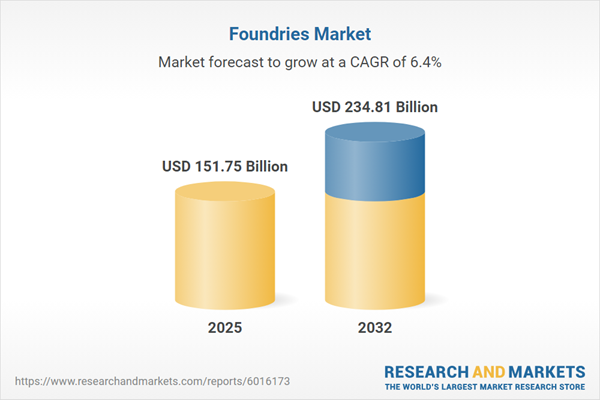Speak directly to the analyst to clarify any post sales queries you may have.
The semiconductor foundry market is evolving rapidly, shaped by ongoing advances in digital applications, high-performance computing, and increasing complexity across global supply chains.
Market Snapshot: Semiconductor Foundries
The foundries market grew from USD 142.65 billion in 2024 to USD 151.75 billion in 2025, backed by a robust CAGR of 6.42%. It is projected to reach USD 234.81 billion by 2032. This sustained growth trajectory is largely attributed to surging demand from automotive, telecommunications, and healthcare sectors, as well as evolving device architectures and increasing market adoption of advanced process nodes. Senior decision-makers will benefit from insights into the competitive landscape, sector innovations, and shifting regulatory frameworks.
Scope & Segmentation
The research report offers an in-depth view across several critical dimensions of the semiconductor foundry ecosystem:
- Process Node
- 28 to 45 Nanometer
- 45 to 90 Nanometer
- 90 to 130 Nanometer
- Above 130 Nanometer
- Below 28 Nanometer
- Wafer Size
- 200 Millimeter
- 300 Millimeter
- Application
- Analog IC
- Logic IC
- Memory IC
- Mixed Signal IC
- Power Devices
- SoC
- End-User Industry
- Automotive
- Consumer Electronics and Smartphones
- Healthcare
- Industrial
- Telecommunications (Mobile Communications, Network Infrastructure)
- Geography
- Americas (North America: United States, Canada, Mexico; Latin America: Brazil, Argentina, Chile, Colombia, Peru)
- Europe, Middle East & Africa (Europe: United Kingdom, Germany, France, Russia, Italy, Spain, Netherlands, Sweden, Poland, Switzerland; Middle East: United Arab Emirates, Saudi Arabia, Qatar, Turkey, Israel; Africa: South Africa, Nigeria, Egypt, Kenya)
- Asia-Pacific (China, India, Japan, Australia, South Korea, Indonesia, Thailand, Malaysia, Singapore, Taiwan)
- Companies
- Taiwan Semiconductor Manufacturing Company Limited
- Samsung Electronics Co., Ltd.
- GlobalFoundries Inc.
- United Microelectronics Corporation
- Semiconductor Manufacturing International Corporation
- Powerchip Semiconductor Manufacturing Corporation
- Vanguard International Semiconductor Corporation
- Tower Semiconductor Ltd.
- HuaHong Semiconductor Limited
- X-FAB Silicon Foundries SE
Key Takeaways for Decision-Makers
- Technological innovation is driving the migration toward smaller process nodes, with foundries increasingly focused on sub-28-nanometer capabilities for high-speed logic and system-on-chip integration.
- Investment in advanced wafer sizes, particularly 300-millimeter substrates, is enhancing economies of scale and reducing per-device manufacturing costs across large-volume applications.
- Partnerships between foundries, design houses, and end-user industries continue to reshape the competitive environment through collaborative technology development and specialized process offerings.
- Emerging regions are actively expanding sovereign manufacturing capacity, emphasizing supply chain independence and encouraging regional self-sufficiency to mitigate geopolitical volatility.
- Regional dynamics vary by market: Asia-Pacific leads in advanced fabrication and packaging, the Americas excel in rapid prototyping, and Europe-Middle East-Africa regions combine legacy manufacturing with sustainable innovation.
- Operational excellence, spanning digital workflow automation and sustainability efforts, is increasingly a differentiator among top-tier foundry operators.
Tariff Impact: U.S. Policy Shifts
Recent U.S. tariff policies have increased complexity across global foundry supply chains. Elevated duties on capital equipment and raw materials have driven foundries to diversify suppliers, revisit procurement schedules, and recalibrate production plans. These changes ripple throughout the industry, leading manufacturers and original equipment makers to emphasize risk-sharing and longer-term agreements. Executives are proactively addressing supply chain resilience and regional diversification to counteract rising input costs.
Methodology & Data Sources
Report insights derive from a robust mix of primary interviews with executives and technical experts within the foundry ecosystem, along with secondary data from regulatory filings, technical papers, and company disclosures. Analytical frameworks such as SWOT, Porter’s five forces, and PESTEL ensure a well-rounded market perspective validated through a multi-layered review process.
Why This Report Matters
- Enables senior executives to anticipate industry shifts and formulate responsive strategies in a competitive, technology-driven market.
- Provides actionable segmentation analysis to support targeted growth initiatives across key process nodes, wafer sizes, and regions.
- Facilitates informed risk management and partnership decisions amid evolving tariff and supply chain challenges.
Conclusion
The semiconductor foundry sector is navigating rapid technological and geopolitical changes. This report offers clear, data-backed analysis to help industry leaders capitalize on growth opportunities while mitigating emerging risks. Informed, agile strategies will determine long-term competitive positioning within this dynamic environment.
Additional Product Information:
- Purchase of this report includes 1 year online access with quarterly updates.
- This report can be updated on request. Please contact our Customer Experience team using the Ask a Question widget on our website.
Table of Contents
3. Executive Summary
4. Market Overview
7. Cumulative Impact of Artificial Intelligence 2025
Companies Mentioned
The companies profiled in this Foundries market report include:- Taiwan Semiconductor Manufacturing Company Limited
- Samsung Electronics Co., Ltd.
- GlobalFoundries Inc.
- United Microelectronics Corporation
- Semiconductor Manufacturing International Corporation
- Powerchip Semiconductor Manufacturing Corporation
- Vanguard International Semiconductor Corporation
- Tower Semiconductor Ltd.
- HuaHong Semiconductor Limited
- X-FAB Silicon Foundries SE
Table Information
| Report Attribute | Details |
|---|---|
| No. of Pages | 192 |
| Published | October 2025 |
| Forecast Period | 2025 - 2032 |
| Estimated Market Value ( USD | $ 151.75 Billion |
| Forecasted Market Value ( USD | $ 234.81 Billion |
| Compound Annual Growth Rate | 6.4% |
| Regions Covered | Global |
| No. of Companies Mentioned | 11 |









